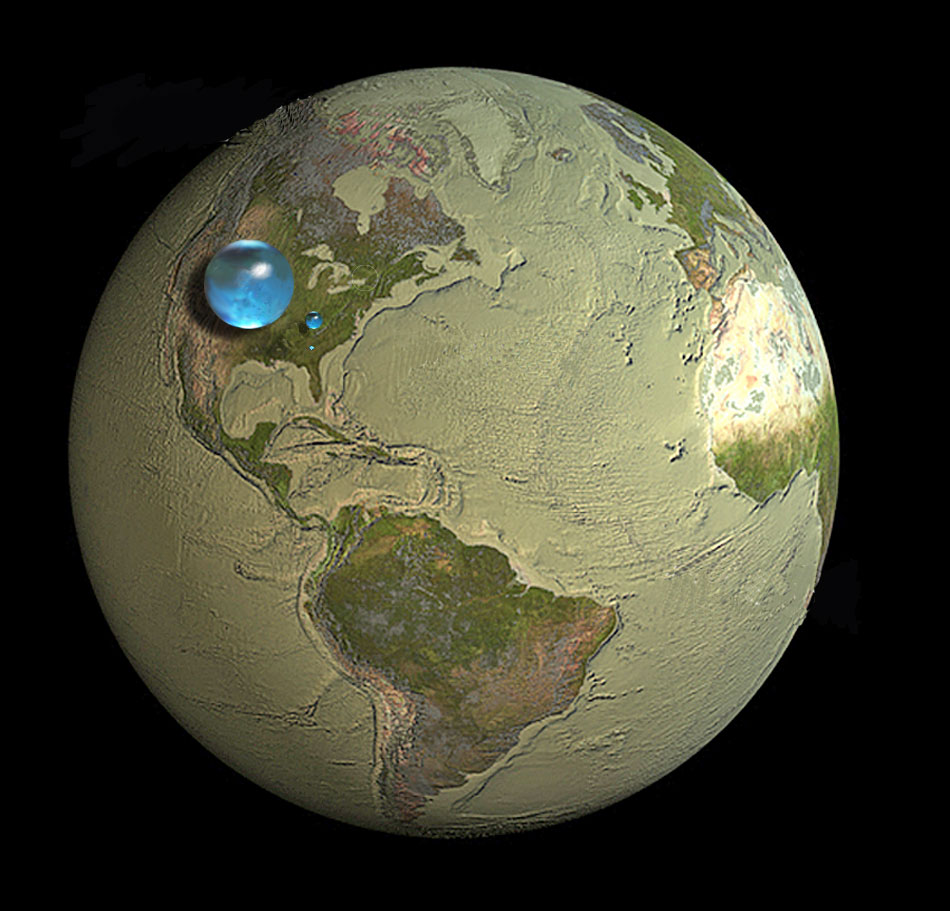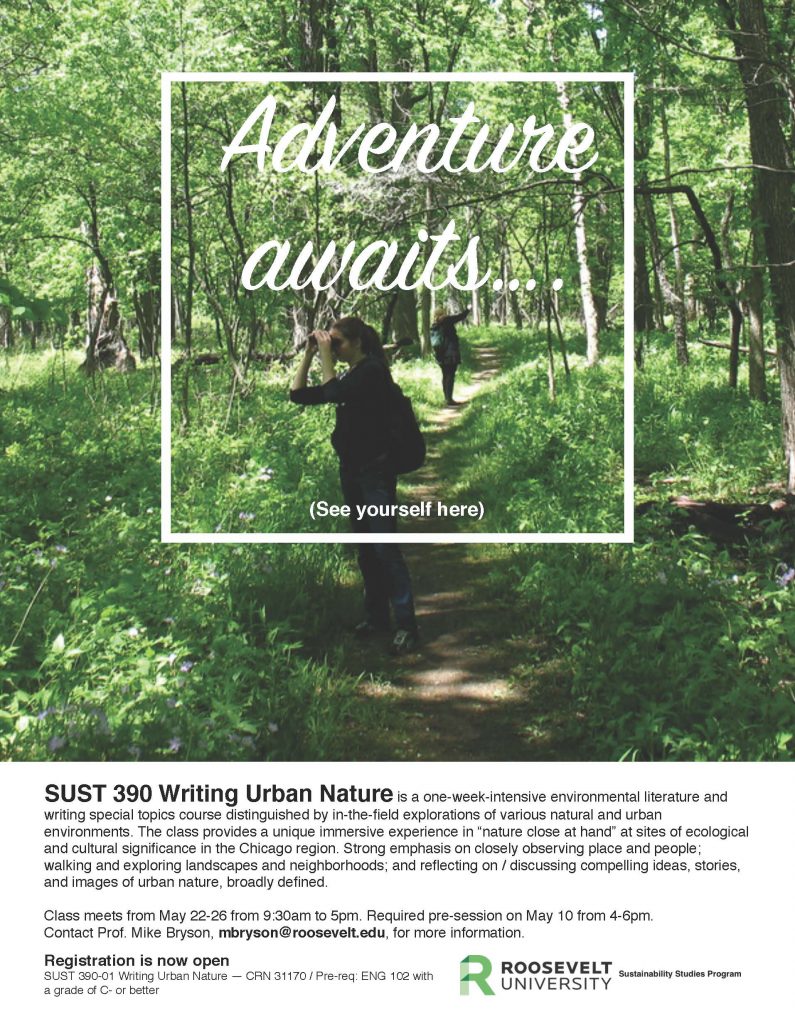 For more details, check out the course preview page here!
For more details, check out the course preview page here!
Please share this poster/link far and wide (pdf).
Category: Photography
Introducing “Rooftop: Second Nature” — Remarks at the Opening Reception, 9 Feb. 2017
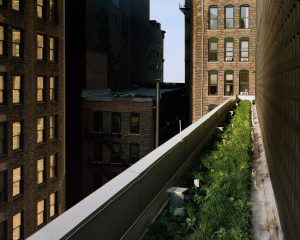
Nature within the urban landscape is simultaneously close at hand and hidden from view — a paradox of proximal obscurity. Yet its myriad forms are as diverse in kind as their human denizens. City parks, urban farms, back yards, forest preserves, vacant lots, and green rooftops — all these and more comprise the spaces of urban nature.
Despite the ubiquity and diversity of urban nature, it remains largely invisible to and thus unappreciated by many city dwellers. We are much more likely to assume nature exists “out there,” away from our cities and suburbs — especially in remote places characterized by few people and sublime landforms. An implicit corollary to that is that the city is unnatural.
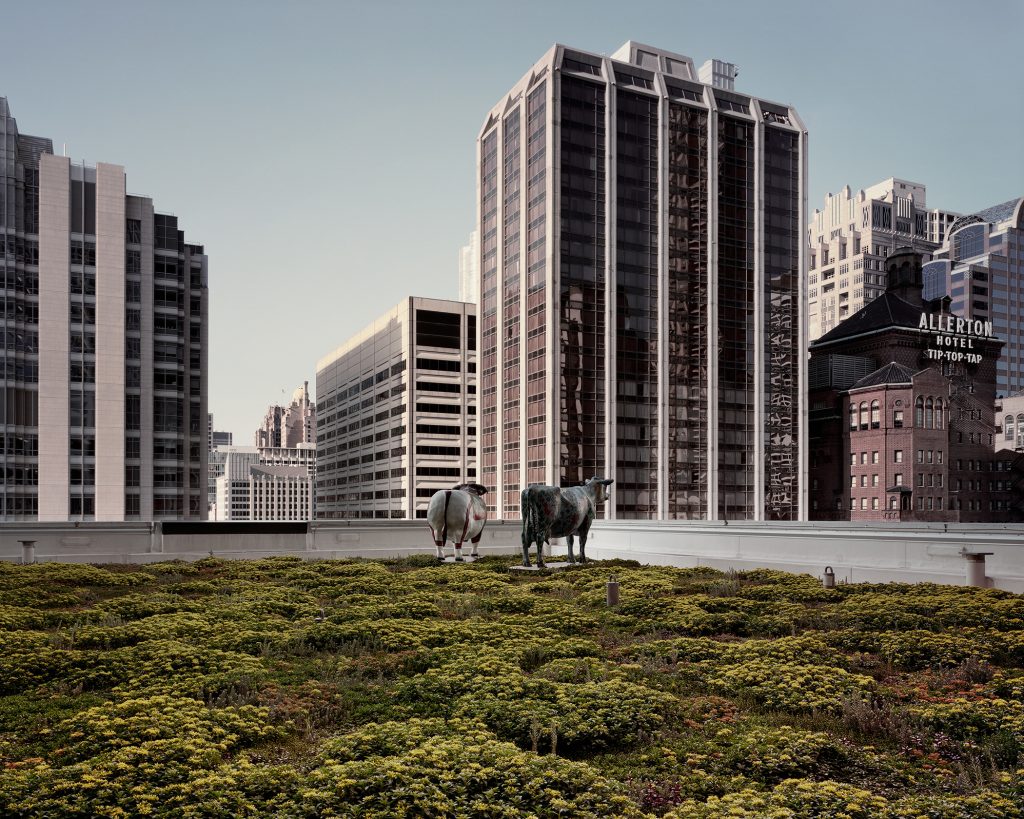
Yet the recent coinage of the seemingly oxymoronic phrase urban wilderness signals that we have begun to re-envision the role of nature within metropolitan landscapes. This nature is almost always hybrid in character, a product of human design and action even when appearing “natural” in outward form. Consider our location right here, along the southwestern rim of Lake Michigan — where the surveyor’s grid was laid down upon the marshy prairie, a river’s current audaciously reversed, and lakefront parkland perched atop thousands of tons of landfill.
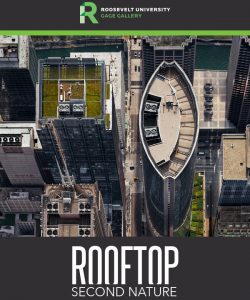 The intersections of the made and the natural can be apprehended in such settings . . . if one observes carefully, knows where to look, and possesses a spirit of exploration. The dramatic roofscapes by Brad Temkin in Rooftop: Second Nature are striking visual compositions that reveal the city from a different and unfamiliar angle, as well as information-rich object lessons in how green infrastructure enhances urban sustainability.
The intersections of the made and the natural can be apprehended in such settings . . . if one observes carefully, knows where to look, and possesses a spirit of exploration. The dramatic roofscapes by Brad Temkin in Rooftop: Second Nature are striking visual compositions that reveal the city from a different and unfamiliar angle, as well as information-rich object lessons in how green infrastructure enhances urban sustainability.
More broadly, though, this exhibit speaks to the vital role played by the environmental arts and humanities in envisioning a more sustainable future for humanity as well as for the millions of fellow species on our beautiful yet vulnerable planet. Thought-provoking ideas, artwork, architecture, poetry, stories, historical accounts, theater, music, and film are necessary complements to painstaking ecological analysis and pragmatic environmental policy.
Why? Because ideas and vision matter. Compelling narratives, whether literary or visual, can animate science, challenge our use of technology, inspire policy, and change hearts and minds. Such narratives must guide our thinking to ensure that social equity and environmental justice are not trampled in the relentless pursuit of short-term profits from, say, building oil pipelines across sources of drinking water in the Great Plains; or dumping the “overburden” of mountaintops into the creeks and rivers of Appalachian coal country; or selling more Pepsi or iPhones.
Skeptics of climate change cannot be persuaded by scientific data and evidence-based policy alone — certainly not when science itself is under unprecedented attack in our society; not when environmental laws are in imminent danger of being dismantled; not when the very status of an observed and documented fact is undermined by the brazen contempt for reason and unsettling embrace of doublespeak that now constitutes the discourse of the new administration.
In such fraught and perilous times, a sustainable future can only be achieved, let alone properly envisioned, with the full participation and engagement of the environmental arts and humanities.
By showing us the “second nature” of the urban landscape in these images of green rooftops, Brad Temkin’s art not only delights and inspires with unexpected manifestations of beauty, but also implicitly challenges us to consider what “first nature” is, and what sort of relationship we want with it — one which in we are conquerors . . . or stewards.
This is a slightly edited version of a short speech I gave at the opening reception for Rooftop: Second Nature on 9 Feb 2017 at Roosevelt University’s Gage Gallery, 18 S. Michigan Ave., Chicago IL. The Gallery is open 9am-5pm weekdays and 10am-4pm Saturdays.
Photography, Sustainability, & Urban Design: “Rooftop: Second Nature” Opens 2/9 at RU’s Gage Gallery
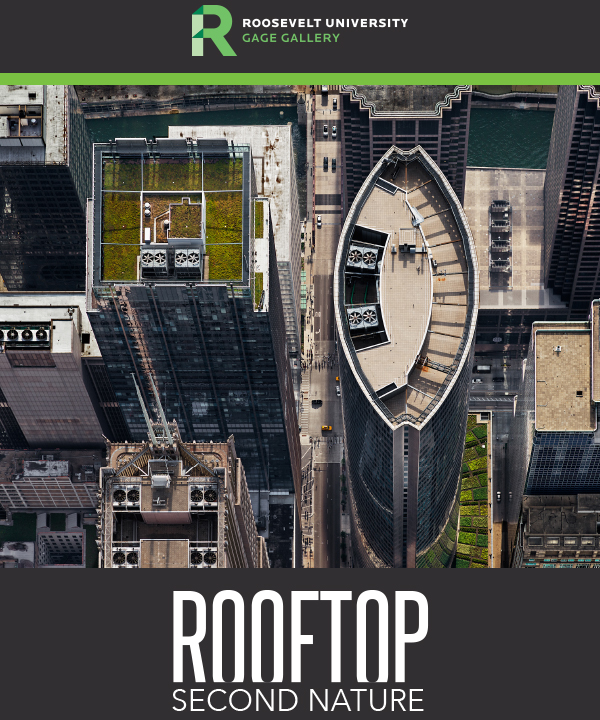 Photographs by Brad Temkin
Photographs by Brad Temkin
February 9 – May 6, 2017
Opening reception and talk by Brad Temkin
Thursday, February 9th, 5-7 p.m.
Roosevelt University’s Gage Gallery
18 S. Michigan Ave., Chicago IL
(312) 341-6458
Statement from the Artist
“Rooftop: Second Nature draws poetic attention to an important new movement to counter the heat island effect caused by city life. Green roofs reduce our carbon footprint and improve storm water control, but they do far more. They reflect the conflict of our existence, symbolizing the allure of nature in the face of our continuing urban sprawl.
“My images do more than merely document rooftop gardens. By securely situating the gardens within the steel, stone, and glass rectangularity of urban downtowns, I ask viewers to revel in their far more open patterns, colors, and connection to the sky. In this break, I see not merely beauty and dichotomy, but the framework for positive change.”
— Brad Temkin
On Urban Ecology, Green Rooftops, and the Sustainability of Cities
Exhibit Essay for Rooftop: Second Nature, Roosevelt University, Spring 2017
What does a sustainable city look like? Solar panel arrays, bike lanes along busy thoroughfares, and urban farms converted from vacant lots all come to mind; but the iconic symbol of the contemporary green metropolis is the green rooftop. Though mostly invisible to us at ground level, these living surfaces embody key chacteristics of the urban ecosystem even as they serve as sustainability badges of honor for environmentally-minded civic leaders.
The science of urban ecology demonstrates that cities are not mere technological constructions, distinct from and diametrically opposed to nature, but complex ecosystems constituted by energy flows and waste sinks, evolving communities of organisms, and habitats both natural and designed. The green rooftops that increasingly dot the skylines of 21st-century cities are engineered to serve specific ecological, economic, and/or aesthetic functions for the buildings they crown and the people who inhabit them. Such spaces are simultaneously technological and natural: well-ordered assemblages of soil, plants, and micro-organisms that soften the surfaces and round the edges of the rectilinear built environment.
Said rooftops also are prime examples of green infrastructure, a critically important element of the urban fabric. Parklands and nature preserves, wetlands and riparian zones, bioswales and rain gardens, farm lots and backyard gardens, and green rooftops — all comprise a city’s green infrastructure. These diverse physical spaces provide a myriad of ecosystem services: they conserve freshwater resources, reduce energy consumption, mitigate air and water pollution, create wildlife habitat, and enable our own physical contact with nature.
The dramatic images in Rooftop: Second Nature are striking visual compositions that reveal the city from a different and unfamiliar angle, as well as information-rich object lessons in how green infrastructure enhances urban sustainability. Within one roof’s environs, a diverse riot of native prairie plants is juxtaposed with the boxy lines of air conditioning units, while other images expand the frame beyond the rooftop’s edge to portray its larger context, such as Chicago’s street grid bisected by its namesake river.
Such visual elements evoke the entanglement of ecological cycles in which the roof participates. These living surfaces provide superior building insulation, thus reducing heating and cooling costs and, in turn, decreasing carbon emissions. Plants evapotranspire water, which cools the micro-climate of the building’s exterior, thus mitigating the urban heat island effect. Precipitation falling on these rooftops is not wasted as runoff to an energy-intensive sewer and wastewater treatment system; rather, it is captured in place, absorbed by the resident plant community, and returned to the atmosphere in a silent yet eloquent demonstration of the water cycle.
Brad Temkin’s photographs are densely layered with meaning and invite inquiry from the viewer: From what vantage point was that shot taken? What are beehives doing on a skyscraper roof? How is this largely unseen rooftop relevant to the river flowing only two blocks away? Who has access to these spaces, and what psychological benefits might accrue from exploring them? Such questions suggest the dynamic interplay between art and science within our perceptions of the sustainable city.
— Michael A. Bryson
Winter Symposium on Sustainability at Augustana College
Today I head west to the city of Rock Island, which hugs the Mississippi River in northwestern Illinois (right across the water from Davenport, Iowa). I’ve been invited to give a talk on urban sustainability issues in Chicago at Augustana College’s annual Winter Symposium, which this year is focused on sustainability and environmental issues. Since I can never resist a chance to talk about urban waterways, my talk is entitled “Paddling the Chicago River: A Good Way to Think about Science, Art, Ethics, and the Sustainability of Cities.”

The degraded yet undeniably charismatic Chicago River is a mighty fine place to contemplate the tangled relationships among water quality, land use, and sustainability within cities and suburbs. As a site for exploring urban nature, an object of analysis in the scientific assessment of water quality and urban ecology, and a case-study in landscape aesthetics, the Chicago river provides students and citizens myriad opportunities to develop a sense of place. More generally, experiencing urban rivers — and understanding their function within the complex watersheds of metropolitan regions — can foster not just ecological literacy about urban ecosystems but also ethical engagement with one’s community.
Here’s a pdf version of my presentation.
Visualizing Earth’s Water
Here is an image posted by one of my students to the last discussion forum of this semester in my Sustainability Studies 220 Water course, along with her comment about it.
It can sometimes be challenging to wrap our minds around water scarcity on Earth when we so often picture it as a blue planet with immensely deep seas. Graphs certainly help to put the idea of water scarcity in perspective, but nothing has driven home this idea as much for me as this image from the USGS. The large blue bubble represents the volume of all the water (salt and fresh) on Earth (its diameter being 860 miles) in comparison to the volume of Earth. The small bubble represents the freshwater on Earth (including the water that is within trees, plants, you and I). And the teeny tiny blue dot by Georgia (look closely) represents all the freshwater that is accessible for our use. It looks smaller than the Great Lakes, but you must imagine it in three dimensions.
We live in a very visual culture. What water-related environmental images have you come across that have had a strong impact on you? What campaigns can you think of that have been successful in using images to impact change? How do you see art, photography, film, etc, having a role in expanding awareness on these critical issues we face? ~Jessie
One of the great things about the USGS page this comes from is that this arresting visual representation of the volume of Earth’s water (and fresh water, and available fresh water) compared to the total volume of Earth as a whole is then accompanied by statistical data and explanations that help us understand the physical story being told in that image. This in turn highlights, and then complicates, the often-evoked dichotomy of image (emotion) and text (reason) — the assumption in popular culture that pictures speak to our hearts and guts, while words appeal to our minds.
Of course, we know that dichotomy to be simplistic, if not simply false. Images such as this do more than pull at our heartstrings — consider the lonely and threatened polar bear here, or seals with fur matted with oil; they get us to think; they cause us to ask questions — in this case, about scale, about the relationship of water to the rest of the Earth’s mass, about the thinness and fragility of the biosphere (which is defined by water, without which there would be no “bio”).
Conversely, textual discourse — whether a poem or a scientific technical report — can stoke our emotions and even spur us to action, especially if we’re open to receiving its message and understand its internal logic. The impacts and effects of both text and image are wonderfully complex, and in the best cases work together more powerfully than they can separately. This example of Earth’s water is a fine case of that, writ large.
The work of science is phenomenally important to the advancement of sustainability in human communities — both in terms of economics and social equity — as well as to the conservation of natural ecosystems, basic resources (air, water, soil), and species. But science alone cannot change the policy that governs our human actions and regulates our excessive tendencies to waste, to think only of the short term, to ignore the unintended consequences of our technologies.
For those huge and ever-present challenges, we also need ideas — and those are debated and created in the creative fires of the arts and humanities in ways that cannot be replicated in scientific and political discourse. For sustainability to be a guiding force of human culture as well as a central feature of our governments (regardless of political persuasion), it needs art, music, literature, and other creative endeavors that define us as a species. And it needs people to connect such expressions to the worlds of science and policy as much as possible, as a means of building bridges and reshaping our views of the world — and our role in it.
Ryan Hodgson-Rigsbee Publishes Urban Nature #10
My friend and fellow urban nature admirer, Ryan Hodgson-Rigsbee, recently left his home turf of Chicago to live in and explore New Orleans. But Ryan’s still creating amazing work about the City of Big Shoulders. Check out his newest edition of the online ‘zine, Urban Nature (#10). I was glad to provide a bit of introductory text to two of the photo essays therein: “The Blizzard” and “While Wandering: Chicago.”
The photo above is from “The Blizzard,” and depicts the Bloomingdale Trail, a proposed elevated rails-to-trails parkland project on Chicago’s North Side. (I mentioned the trail in this blog essay on urban nature published last year.)
New Book on the Chicago River’s Reversal
The reversal of the Chicago River — one of the great engineering projects of the late 19th century — impacted both the watersheds of the Chicago Region as well as the economy of the city and its suburbs. While that transformation and its consequences have been much discussed, a new photo book significantly adds to that documentation, as discussed by a recent article in the Chicago Sun-Times:
Beginning in 1894, photographers set out to document the mammoth project. Some of those 22,000 images are now featured in the recently released book by Richard Cahan and Michael Williams, “The Lost Panoramas; When Chicago Changed its River and the Land Beyond.” Few of the images have ever been seen before, the authors say. The negatives were recently discovered by accident in a basement of the James C. Kirie Water Reclamation Plant in Des Plaines.
 “Nearly every photo is panoramic in nature — wide-angle, unobstructed views of a world that no longer exists,” the authors write.
“Nearly every photo is panoramic in nature — wide-angle, unobstructed views of a world that no longer exists,” the authors write.
The book, published by CityFiles Press, retails for $45. Cahan is a former Chicago Sun-Times picture editor.
The Character of Urban Nature
Nature within the urban landscape is simultaneously close at hand and hidden from view — a paradox of proximal obscurity. Yet its myriad forms and manifestations are as diverse in kind as their human denizens. City parks, community gardens, nature centers, green rooftops, restoration sites, golf courses, back yards, alleys, vacant lots, landscaped public spaces, plus the resident non-human biota in all its riotous diversity and plenitude — all these and more comprise urban nature.
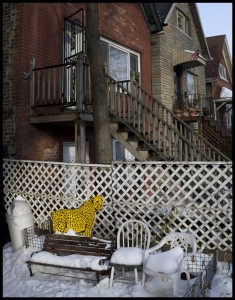
Despite the ubiquity and fascinating heterogeneity of urban nature, it remains largely invisible to and thus unappreciated by many city dwellers. We are much more likely to assume nature exists “out there,” away from our cities and suburbs — especially in remote depopulated places characterized by the well worn but still compelling aesthetics of the beautiful or the sublime. Our culture assumes that city, country, and wilderness are distinct landscape types with clear regional boundaries, and an implicit corollary to that is that the city is unnatural. The fact that urban green spaces are often compromised and degraded by pollution, development, or overuse only underscores that point. Yet the recent coinage of the seemingly oxymoronic phrase “urban wilderness” signals that ecologists, artists, environmental advocates, and citizens have begun to re-envision the role of nature within metropolitan landscapes.
Just about any American city could serve as a fruitful setting for analyzing the character and significance of urban nature; indeed, such analyses are best done with the specificity of a particular locale in mind. Consider, then, Chicago. The Windy City’s natural and cultural histories are not only long-studied and well-documented, but also inextricably linked with how we’ve thought about, confronted, transformed, abused, and (of late) restored the natural environment of urban areas. From its beginnings as a marshy trading post on the banks of the Chicago River, to its amazing expansion as an industrial power during the 19th and 20th centuries, to its profound reshaping of the physical landscape in that process, to its ascension as a global city in the 21st century that strives to be environmentally progressive — Chicago is an ideal laboratory in which to study the diverse manifestations of nature in urban spaces.
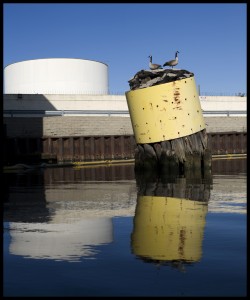
This nature is almost always hybrid in character, a product of human action (whether deliberate or not) even when appearing “natural” in outward form. Chicago, the self-proclaimed City in a Garden, has spent the better part of its brief existence unapologetically bending nature to its will, from the audacious engineering feat of raising the grade level of its streets and buildings in the mid-19th century in order to install a proper sewer system, to the subsequent development of lakefront parklands atop countless tons of landfill, to the famous reversal of the Chicago River’s current.
This interconnection of the made and the natural can be read in the landscape . . . if one observes carefully and knows where to look. Such is the ongoing quest of photographer and urban explorer Ryan Hodgson-Rigsbee, who investigates and documents the Chicago cityscape on foot, by bicycle, and aboard a kayak. Hodgson-Rigsbee’s growing body of photographs are a stunning visual echo of the urban nature writings of Leonard Dubkin (1905-1972), a journalist and self-taught naturalist who chronicled his explorations of and observations about Chicago’s urban landscape in the middle decades of the twentieth century, and who found a surprising biotic diversity within otherwise unremarkable settings such as vacant lots, railroad buffer zones, or residential yards. Even more importantly, Dubkin advocated the need for human connection to the wildlife — and patchwork of wild lands — that remained close at hand, within the city’s borders, an implicit theme of some of Hodgson-Rigsbee’s landscapes.
The splendid diversity of nature in Chicago can be categorized in many ways, one of which consists of a simple binary: official and unofficial. The former includes the green spaces purposefully designed and designated for human use (parklands of all kinds) as well as the conservation of natural resources (forest preserves, wetland conservation sites, prairie restoration areas). These areas comprise the official version of Chicago’s urban nature — the sort that is featured on the city’s website and which collectively is an incredibly important and irreplaceable resource for the interaction of people with the natural world. The “unofficial countryside” of Chicago, though — to use a phrase from the English naturalist-writer Richard Mabey — is the hardscrabble, unexpected, and often uncared-for everything else. It is this which drew the eye of Dubkin in the last century, and which is now framed by the camera of Hodgson-Rigsbee.
One such place, little known yet vast and in plain view, is sometimes referred to as The Brownlands. A sprawling 100-plus acre tract of empty land a mile or so south of the soaring skyscrapers of Chicago’s Loop and just north of the bustling Chinatown neighborhood, the Brownlands are readily visible to hundreds of commuters each day as they make their way into the city on the Rock Island Line commuter train.

Incredibly, part of this land was once water. The South Branch of the Chicago River wound its way through the area, bending eastward toward Lake Michigan before meandering back west and resuming its southerly course. This D-shaped curve of the river’s channel proved inconvenient for shipping and an impediment to street transportation improvements; so the river here was straightened and channelized in the late 1920s, a water infrastructure project of great scale, expense, legal complexity, and civic ballyhoo, for the reordered urban landscape was supposed to usher in an era of unprecedented economic development for this industrialized area of the city.
These plans never quite materialized, for the through streets on this “reclaimed” land were never completed. The Brownlands thus remain mostly vacant and part of Chicago’s unofficial countryside. Long owned by a railroad well into the late twentieth century, the land was sold to speculative developers in the late 1990s and has changed hands a few times since, though the goal of these recent landowners has not changed. They envision, predictably but unimaginatively, an ambitious riverfront development project of fashionable residences and upscale retail establishments. Fortunately, the mammoth expense of such a project has kept it in limbo, and the Brownlands persist in 2011 as a wide-open space of non-native brush and invasive weeds, patches of prairie grasses which hint at the land’s pre-settlement ecological legacy, informal pathways and abandoned gravel roads, discarded vehicles and miscellaneous machinery, and furtive human visitors who brave the fenced barriers and No Trespassing signs to explore, camp, photograph, bird, even live in the Brownlands.
An example of a contemporary frontier-like space in the middle of America’s third-largest city, the Brownlands simultaneously evoke the past technological transformation of Chicago’s landscape and the present human yearnings for off-the-grid experiences with an unmediated nature. They also hearken to an uncertain future in which yet another large-scale development project may dramatically alter what is now an open space in the shadow of Chicago’s Loop with remarkable restoration and recreation potential.
Another significant hybrid place where nature and the built environment converge is the Bloomingdale Trail, an abandoned elevated train line that runs for nearly three miles on the city’s near-North Side. A grassroots non-profit organization, Friends of the Bloomingdale Trail, is in the process of raising funds to convert the defunct railway into an elevated greenway/trail, citing the recently developed High Line linear park in Manhattan as model and inspiration. Currently the project enjoys the backing of some influential politicians (including the outgoing mayor, Richard M. Daley, a noted environmental progressive), but needs to raise upwards of $60 million to finance construction in hopes of completing the Trail by 2016.
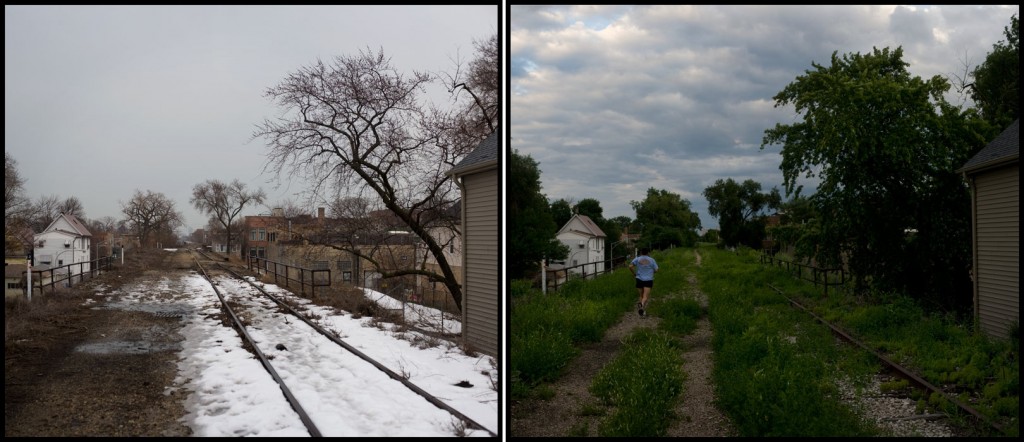
Beyond the politics and economics of its development, this proposed parkland is notable for the ways in which it will perform multiple functions and tie together the built and natural landscapes with the city’s diverse human denizens in mind. Part greenway, part commuter route, part public art tableau, part recreational space, the Bloomingdale Trail illustrates how urban space can be re-imagined to embody sustainable transportation alternatives for everyone from children walking to their neighborhood schools to cyclists commuting from their homes to nearby elevated train stations on the CTA Blue Line. Besides these immediate practical benefits, though, the Trail exemplifies the many nature/culture hybrid spaces in Chicago that are in various stages of transition from an old “brown” urban infrastructure of steel and asphalt to a new “green” infrastructure of recreational trails, native plant communities, and ecology-minded landscapes. What is common to this and similar projects in Chicago and other cities is that they do not simply happen because they are good ideas; they require immense amounts of human and financial capital to conceptualize and bring to fruition, even when the political winds are favorable.
The Brownlands and the Bloomingdale Trail are but two examples of Chicago’s unofficial countryside that exists apart from the formally designated parklands, forest preserves, and other green spaces of the city. These and other hybrid spaces are amalgams of nature and culture, places that dramatize the earth’s vulnerability to human alteration even as they show us the resilience and adaptability of plant and animal life within the constraints imposed by brick, steel, and concrete. For the artist, they present a nearly inexhaustible subject for representing the complexities and paradoxes of nature in the city.
An excerpt from this essay was published as the introductory text to While Wandering: Chicago, a book a photographs by Ryan Hodgson-Rigsbee (Urban Nature Media, 2011).
